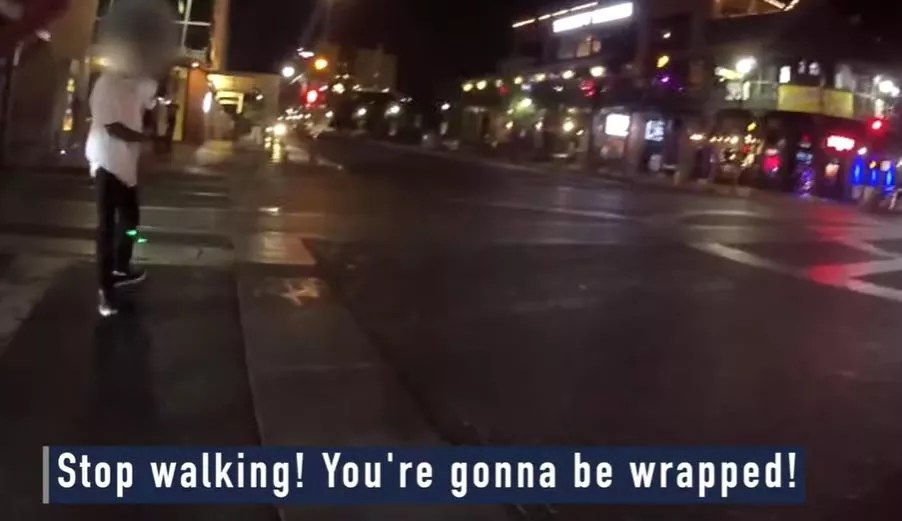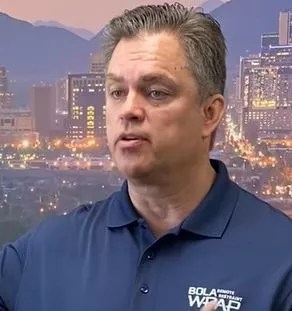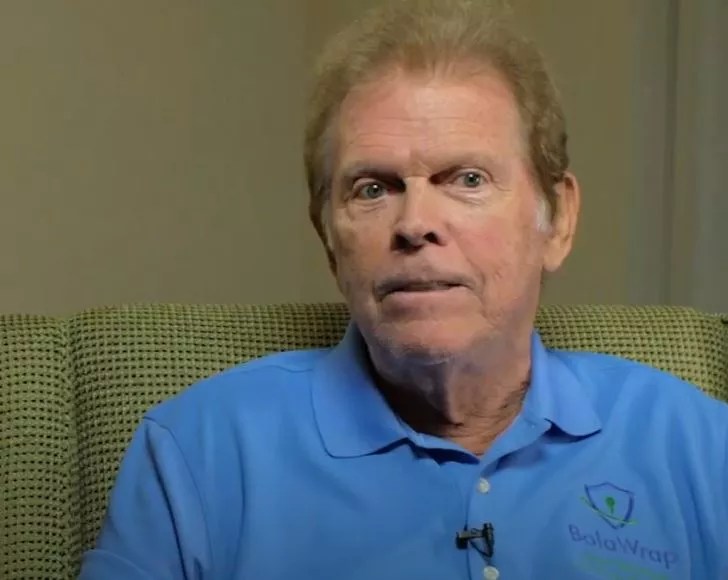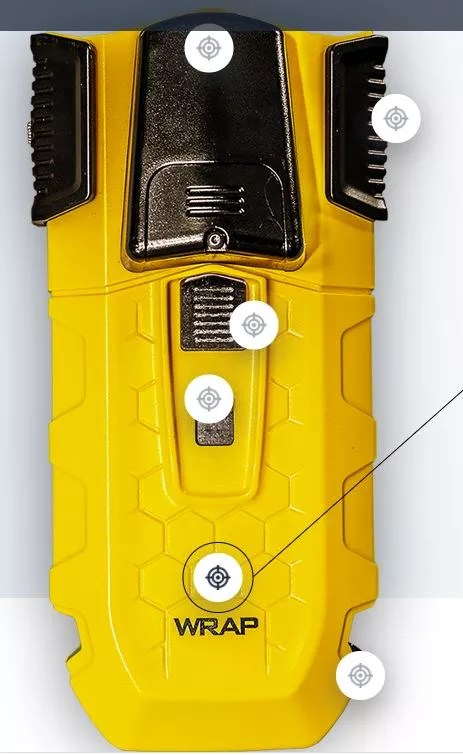
YouTube

Audio By Carbonatix
On Tuesday, BolaWrap released bodycam video touting the first use of its tether-shooting device in the company’s own hometown of Tempe.
The Nasdaq-listed company, whose president is the founder and former chairman of Taser International, said a May 28 incident on Mill Avenue is the latest example of a new “tool” that can help reduce deadly encounters with police. Its signature product, the BolaWrap, shoots a Kevlar cord at people that can wrap their arms or legs. The device is being used increasingly by police agencies around the country since emerging on the market in 2019.
Called a “Spider-Man gun” by some and compared to the net-throwing weapon in the 1968 original Planet of the Apes movie, the product is described on the company’s website as a “hand-held remote restraint device” that shoots an eight-foot tether at 513 feet per second, or about 340 miles per hour, toward its target.
This year, make your gift count –
Invest in local news that matters.
Our work is funded by readers like you who make voluntary gifts because they value our work and want to see it continue. Make a contribution today to help us reach our $30,000 goal!

Tom Smith, president and CEO of BolaWrap
Taking the name “bola” (Spanish for ball) from a snaring weapon used for centuries by indigenous people and gauchos in South America, it can reportedly wrap a person at a range of 10 to 25 feet. Instead of balls at the end of the tether, the BolaWrap has weighted, barbed hooks.
Tom Smith, the president and CEO of BolaWrap, attributed the idea for the device to Woody Norris, the inventor of the sound-focusing “acoustic cannon” used by some military and police forces. When Norris’ idea for a handheld acoustic system wouldn’t work, Norris came up with the BolaWrap, Smith said.
The 1.5-minute video features bodycam footage from one or more officers as they deal with a man “running through traffic” who was “in crisis and armed with a stun gun,” according to text added by BolaWrap. The man in a white T-shirt seems confused as police tell him not to walk in the street, then the video cuts to him being ordered to get on the sidewalk. He apologizes but doesn’t drop the stun gun as ordered, instead holding it out in front of him as he crosses Mill Avenue at Fifth Street.
“Hey guys, I’m gonna Bola,” one officer says. A horizontal green line shines across the back of the man’s knees. The Kevlar tether explodes out of the device with a sound similar to a gunshot and wraps around the man’s legs. A moment later he’s being handcuffed.
“That works really well,” one officer says in the video.
Tempe police were unable to respond to questions about their purchase of BolaWrap devices by press time. Tempe’s former police chief, Sylvia Moir, who stepped down and retired in October – ostensibly due to concerns about her leadership in the post-George Floyd era – took a job in January with BolaWrap as an advisor and liaison to law enforcement agencies.
A Gentler Use of Force
The arrested man wasn’t obeying orders, and “that’s where this technology really shines – that early intervention to stop it from escalating,” Smith said.
In the promotional video, Tempe Police Chief Jeffrey Glover echoes this comment, saying, “The Tempe Police Department is training constantly to improve our de-escalation and resolution efforts. We strive to be very attuned to individuals that may be suffering from mental illness or dementia, disoriented, or potentially impaired.”
Sergeant David Jones of the Avondale Police Department noted that the devices work well in specific applications, but not others.
“For someone who is resisting or assaulting an officer – it’s not going to be effective in those types of encounters,” he said.
With the city council’s approval, Avondale PD purchased 11 of the devices in the fall of 2019 for about $1,000 apiece, Jones said. Each squad, made up of 5 to 8 officers, now will have at least one officer trained in the use of the BolaWrap. Ultimately, that boils down to three or four BolaWrap devices “on the road” in Avondale at any given time, said Jones, who works as the department spokesperson and training division sergeant.

Elwood “Woody” Norris, inventor of the BolaWrap.
The department has deployed the device in the field just once, so far. It was a few months back, late at night, with a suicidal man “running around the middle of the road” armed with a “large knife.” Police who came upon the scene had a plan: Officers would rush the man with the shield as another stood by with the bola-shooter. The combo of shield and BolaWrap worked well, Jones said, adding that another officer likely had his gun at the ready, too.
Besides shooting the tether, simply deploying the weapon and its green-laser sight might prove a deterrent for some people, and the gunshot sound of the weapon going off could also take the fight out of someone, he said.
Avondale allows officers to use the weapon when rules dictate that a taser should not be used. Police only shoot taser barbs at someone who’s displaying “active aggression,” which could mean making a fist or actually striking out. Officers could BolaWrap someone displaying passive resistance, such as not complying with an officer’s commands, but even then Jones envisions that using the device would be to help with a mental health crisis. Jones said he teaches officers not to BolaWrap someone just for “mouthing off.”
Potential for Problems
When tasers first found their way to police duty belts in the 1990s, agencies in Arizona and elsewhere often allowed officers to use them on those who passively resisted commands. After some people died after being tased and the high-profile tasings involving children and people who simply refused to stand up as ordered, police changed the use-of-force rules for tasers. Jones said he doesn’t think the same thing will happen with BolaWrap devices. The device is not as invasive as a taser and doesn’t use pain for compliance, he pointed out; he’s been “wrapped” numerous times without mishap.
There’s always a potential for problems, he acknowledged. People wrapped in the legs or arms could fall and hit their heads. And when people are wearing shorts, the barbed hooks could dig into someone’s legs, he said.

The BolaWrap
wrap.com
Still, it’s better than having to kill someone – which the department did in January.
Besides firearms, Avondale uses tasers and 40mm “sponge round” launchers as “less lethal” weapons.
The BolaWrap is “something else we can use,” Jones said. “With the narrative kind of the way it is … we looked for other options that could be potentially beneficial to officers on the road.”
Smith is the founder and former chair of Taser International, which changed its name to Axon in 2017. He left Taser in 2013 to work on startup companies, leaving his brother, Rick, to run the firm.
While tasers are controversial products that generate constant lawsuits for alleged misuse and excessive force, Smith said no lawsuit over the use of BolaWraps has been filed anywhere that he knows of. Smith said experts helped ensure the safety of BolaWrap and guide the training of its use.
With tasers, which release electricity into the body, a subject “physically locks up,” Smith said. BolaWraps don’t put anything inside of anybody, and a person’s reflexes still work to “catch themselves or turn or roll to try to protect themselves” in a fall, he said. In other cities, a BolaWrap once hit someone in the face, while another wrapped around someone’s neck. “It did not injure them,” Smith said.
He called the BolaWrap the first significant new “tool” for police since the taser more than 20 years ago.
“How many times do you get to change the world, let alone do it twice?” Smith said.